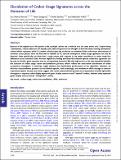| dc.contributor.author | Novoa Pardo, Eva Maria | |
| dc.contributor.author | Jungreis, Irwin | |
| dc.contributor.author | Jaillon, Olivier | |
| dc.contributor.author | Kellis, Manolis | |
| dc.date.accessioned | 2021-01-27T21:40:31Z | |
| dc.date.available | 2021-01-27T21:40:31Z | |
| dc.date.issued | 2019-05 | |
| dc.identifier.issn | 0737-4038 | |
| dc.identifier.issn | 1537-1719 | |
| dc.identifier.uri | https://hdl.handle.net/1721.1/129590 | |
| dc.description.abstract | Press on behalf of the Society for Molecular Biology and Evolution. Because of the degeneracy of the genetic code, multiple codons are translated into the same amino acid. Despite being "synonymous," these codons are not equally used. Selective pressures are thought to drive the choice among synonymous codons within a genome, while GC content, which is typically attributed to mutational drift, is the major determinant of variation across species. Here, we find that in addition to GC content, interspecies codon usage signatures can also be detected. More specifically, we show that a single amino acid, arginine, is the major contributor to codon usage bias differences across domains of life. We then exploit this finding and show that domain-specific codon bias signatures can be used to classify a given sequence into its corresponding domain of life with high accuracy. We then wondered whether the inclusion of codon usage codon autocorrelation patterns, which reflects the nonrandom distribution of codon occurrences throughout a transcript, might improve the classification performance of our algorithm. However, we find that autocorrelation patterns are not domain-specific, and surprisingly, are unrelated to tRNA reusage, in contrast to previous reports. Instead, our results suggest that codon autocorrelation patterns are a by-product of codon optimality throughout a sequence, where highly expressed genes display autocorrelated "optimal" codons, whereas lowly expressed genes display autocorrelated "nonoptimal" codons. | en_US |
| dc.description.sponsorship | Human Frontier Science Program (Award LT000307/2013- L) | en_US |
| dc.description.sponsorship | Australian Research Council (Award DE170100506) | en_US |
| dc.description.sponsorship | NIH (Grant R01 HG004037) | en_US |
| dc.description.sponsorship | Wellcome Trust (Grant U41 HG007234) | en_US |
| dc.language.iso | en | |
| dc.publisher | Oxford University Press (OUP) | en_US |
| dc.relation.isversionof | http://dx.doi.org/10.1093/molbev/msz124 | en_US |
| dc.rights | Creative Commons Attribution 4.0 International license | en_US |
| dc.rights.uri | https://creativecommons.org/licenses/by/4.0/ | en_US |
| dc.source | Oxford University Press | en_US |
| dc.title | Elucidation of Codon Usage Signatures across the Domains of Life | en_US |
| dc.type | Article | en_US |
| dc.identifier.citation | Novoa, Eva Maria et al. "Elucidation of Codon Usage Signatures across the Domains of Life." Molecular Biology and Evolution 36, 10 (May 2019): 2328–2339 © 2019 The Author(s) | en_US |
| dc.contributor.department | Massachusetts Institute of Technology. Computer Science and Artificial Intelligence Laboratory | en_US |
| dc.relation.journal | Molecular Biology and Evolution | en_US |
| dc.eprint.version | Final published version | en_US |
| dc.type.uri | http://purl.org/eprint/type/JournalArticle | en_US |
| eprint.status | http://purl.org/eprint/status/PeerReviewed | en_US |
| dc.date.updated | 2021-01-05T18:16:42Z | |
| dspace.orderedauthors | Novoa, EM; Jungreis, I; Jaillon, O; Kellis, M | en_US |
| dspace.date.submission | 2021-01-05T18:16:47Z | |
| mit.journal.volume | 36 | en_US |
| mit.journal.issue | 10 | en_US |
| mit.license | PUBLISHER_CC | |
| mit.metadata.status | Complete | |
